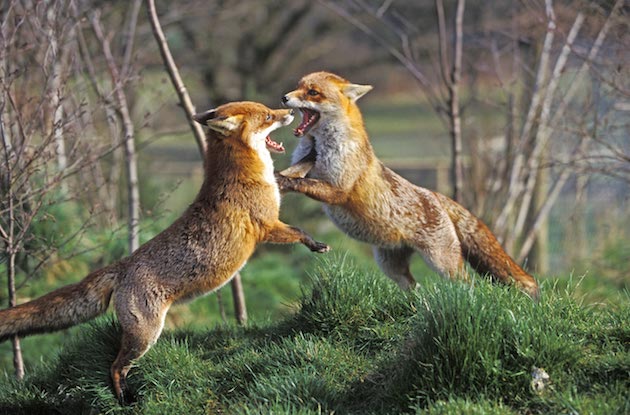All about the fox
Patrick Hook gives the lowdown on a creature that is renowned in folklore. Read on if you don't want to make a Charlie of yourself.

Foxes play fighting
I thought it was time to do a piece all about the fox. Let’s address some of the various questions that the fox shooter often encounters.
Can you eat fox?
The short answer is yes, but the meat is generally considered to be tough with an unpleasant taste. The late great Clarissa Dickson Wright had a recipe that saw the fox skinned and gutted and then hung for three days before being stewed as though it were a rabbit. She recommended that it be eaten with a chestnut pasta. I consider myself reasonably adventurous with my food, however, having seen what can slither its way out of a dead fox, I won’t be rushing to try it this Christmas.
Why is the fox often called ‘Reynard’?
Reynard actually derives from ‘Raginhard’ which itself is said to be an old Germanic name that means ‘Strong in counsel’. There are many different spellings, such as ‘Reinhard’, which has been dated to around 1180. Around this time the French adopted it as the official label by which the fox became known, although their spelling these days is ‘Renard’.

Many woods and covers in the countryside were planted specifically for foxes to breed in.
Shouldn’t we just leave foxes alone and let nature take its course?
The stark fact is that had we done this, the fox would have become extinct in the UK many hundreds of years ago. The loss of habitat due to population increase meant that there were few large animals left to hunt in this country, particularly from the 17th century onwards. In order to prevent such a calamity, the hunting fraternity therefore imported vast numbers of foxes from places like France, Germany and Holland. The countryside of today is very much a product of the same ethos.
If it wasn’t for the hunting set, there would be very few woods and covers left in the countryside, many of which were planted specifically for foxes to breed in.
While we shooters may not always have the smoothest of relationships with the hounds people, our wildlife owes them a debt of gratitude.
Why is the fox considered to be sly?
The expression ‘Sly as a fox’ is one that has been around for centuries and basically means that the animal or person concerned uses experience and cunning to get whatever it is they want, often by unscrupulous actions. This approach was exemplified in Aesop’s Fables, which are attributed to a storyteller who lived in ancient Greece between 620 and 564 BC.
He used his series of fables to address religious, social and political themes, but set them among animals to avoid governmental persecution. Among the many stories, there are 28 that include the fox.
How to call a fox
HOW TO SQUEAK A FOX: Here the Nataional Gamekeepers Organisation tell you how to call in a fox.
What is the best rifle for shooting foxes?
What’s the best rifle for foxing? How should you choose?
Are foxes legally classed as vermin?
Never mind the fox, according to a question put to Her Majesty’s government in 2003, even the term ‘vermin’ isn’t defined in UK law. The respondent on the occasion went on to say that the Oxford English Dictionary definition should be used instead. I therefore dragged my rarely thumbed copy down from the shelf and checked the relevant entry.
It said: Mammals and birds injurious to game, crops, etc., e.g. foxes, weasels, rats, mice, moles, owls, etc.
Now I accept that my copy is somewhat dated, but I was still surprised to see that owls were ever considered to be vermin. How times have changed.










